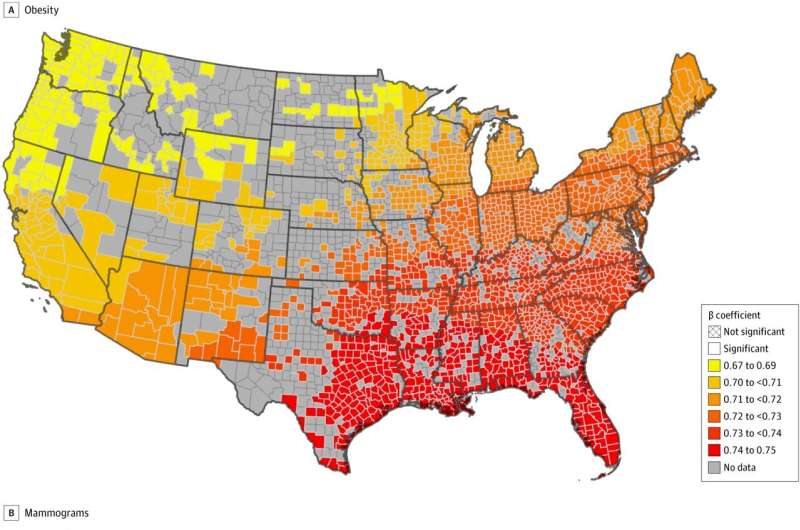This article has been reviewed according to Science X's editorial process and policies. Editors have highlighted the following attributes while ensuring the content's credibility:
fact-checked
peer-reviewed publication
trusted source
proofread
With breast cancer risks, where you live matters, researchers find

Inadequate health care access, unhealthy diets and not enough exercise are all well-known risk factors for the number one cause of cancer-related deaths in women—breast cancer—but what was never clear is why death rates for the disease differ regionally.
But now, researchers from the University of Maryland with collaborators from George Mason University have identified patterns of breast cancer survival that link social and environmental factors with geographic regions across the United States.
Their study, published in JAMA Network Open, revealed that limited access to healthy food was correlated with lower breast cancer survival rates in the East and Southeast, but not in the West or Southwest.
Meanwhile, opportunities for exercise were a more significant determinant of breast cancer survival in the Southwest than elsewhere. Location had enough influence that mortality could sometimes vary between adjacent towns and neighborhoods that had similar risks, they found.
One of the most innovative aspects of the study was that the researchers did not have to conduct multiple, location-based surveys to find these patterns. Instead, they analyze large-scale national datasets on human health, environmental conditions, and social and demographic information.
"By looking at these large national datasets in this novel way, we were able to take into account these spatially specific hotspots and identify where the effects of different risk factors were most significant," said Travis Gallo, assistant professor in the Department of Environmental Science and Technology (ENST) at UMD and co-author of the study. "With this extra information, you could design very culturally specific interventions to reduce breast cancer mortality."
Gallo and his team, which included Dan Herrera, an ENST graduate assistant, were suspicious of the traditional view that the significance of each risk factor is uniform across the country. As a quantitative ecologist, Gallo applied similar techniques to the ones he uses studying animals to tease out regionally specific information and make inferences about how factors influencing mortality rates varied in each region down to the county level.
He and his colleagues found that some risk factors, like obesity and limited access to mammogram screenings, are consistently associated with high breast cancer mortality rates regardless of geographical location. But other risk factors, like food deserts and pollution, varied in importance from place to place, although specific reasons for the differences were beyond the scope of the study.
The study can help public health officials more effectively target programming, funding and messaging around specific risk factors where they're likely to have the most impact, the researchers said. For example, public health officials could more effectively reduce obesity and overall risk of breast cancer by addressing the different risk factors that contribute to obesity in each region.
In addition, because food deserts are more strongly associated with breast cancer mortality rates in majority-Black communities in the East and Southeast, efforts to increase access to healthy food and public health messages around food could be designed to be culturally relevant to those communities.
Likewise, exercise opportunities are more relevant to survival rates in the Southwest where larger communities of Indigenous and Hispanic populations live, so programs to reduce breast cancer mortality in these regions can be designed to be relevant to those communities.
More information: Taylor Anderson et al, Geographical Variation in Social Determinants of Female Breast Cancer Mortality Across US Counties, JAMA Network Open (2023). DOI: 10.1001/jamanetworkopen.2023.33618
















